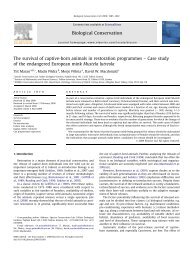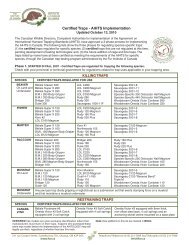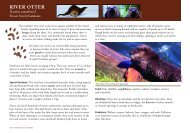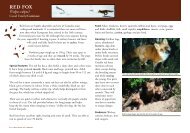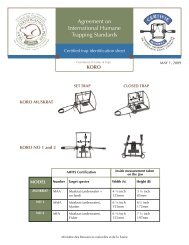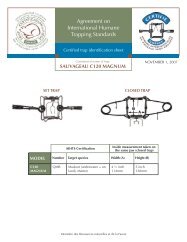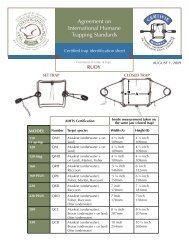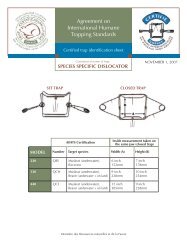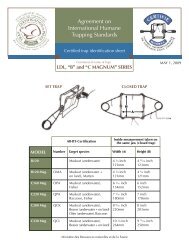Density, demography, and functional response of a harvested wolf ...
Density, demography, and functional response of a harvested wolf ...
Density, demography, and functional response of a harvested wolf ...
Create successful ePaper yourself
Turn your PDF publications into a flip-book with our unique Google optimized e-Paper software.
national parks. Comparisons <strong>of</strong> current <strong>wolf</strong> density in the Nordegg area to estimatesderived by Clarkson et al. (1984) <strong>and</strong> Schmidt <strong>and</strong> Gunson (1985) indicate that wolveshave increased within the western portion <strong>of</strong> the Clearwater Area during the past 2decades, which coincides with anecdotal reports from trappers <strong>and</strong> outfitters. While noprevious estimates <strong>of</strong> <strong>wolf</strong> density exist for the lower foothills portion <strong>of</strong> the ClearwaterArea, our estimates are similar to or higher than those recorded near the Simonette River(Bjorge <strong>and</strong> Gunson 1989: 10.8 to 23.8 wolves/1000 km 2 ), in the Swan Hills (Fuller <strong>and</strong>Keith 1980: 12.0 wolves/1000 km 2 ) <strong>and</strong> more recently, in caribou ranges in west-centralAlberta (Kuzyk 2002: 11 wolves/1000 km 2 ).Low rates <strong>of</strong> natural mortality, coupled with high pup production <strong>and</strong> low emigrationrates, allowed wolves to sustain a liberal management regime <strong>and</strong> harvest rates <strong>of</strong> 35%.Harvest <strong>of</strong> wolves did not appear to negatively impact <strong>wolf</strong> reproductive success becausemostly pups (55%) were <strong>harvested</strong>, <strong>and</strong> susceptibility <strong>of</strong> breeding-age wolves to hunting<strong>and</strong> trapping appeared to be low. While the current <strong>wolf</strong> harvest regime in the ClearwaterArea does not appear to be causing population declines, <strong>wolf</strong> dispersal rates were lowerthan in most un<strong>harvested</strong> <strong>wolf</strong>populations (Fuller et al. 2003),<strong>and</strong> success <strong>of</strong> immigrants maybe low due to high mortality ratesin the transient segment <strong>of</strong> thepopulation (Adams et al. 2008).However, <strong>wolf</strong> densities are highoverall, <strong>and</strong> wolves do dispersefrom the study area <strong>and</strong> live longenough to breed in other areas.We confirmed that nearly 25% <strong>of</strong>wolves leave their pack eachyear, <strong>and</strong> Thiessen (2007) usedgenetic analyses to documentdispersal from the ClearwaterArea to all adjacent subpopulations, including those encompassing Banff <strong>and</strong> JasperNational Parks. Therefore, concerns that current <strong>wolf</strong> management may prevent dispersalfrom the Clearwater Area into the adjacent National Parks (Callaghan 2002) appearunfounded.On a year-round basis, wolves are the primary predator <strong>of</strong> adult female elk in theClearwater Area (Frair 2005, Hebblewhite 2006), <strong>and</strong> our study results can be used tohelp assess the effects <strong>of</strong> <strong>wolf</strong> predation on ungulate populations in harvest models.However, we provide only winter kill rates, <strong>and</strong> annual kill rates would be needed to fullyunderst<strong>and</strong> the potential impacts <strong>of</strong> <strong>wolf</strong> predation. At present, there is some debate overwhether <strong>wolf</strong> kill rates in summer are generally higher or lower than those in winter(Jedrzejewski et al. 2002, S<strong>and</strong> et al. 2008). In either case, for most <strong>wolf</strong> packs, elk areclearly a secondary prey species, indicating that <strong>wolf</strong> predation on elk is decoupled fromelk densities. In this case, the ecological relationship between elk <strong>and</strong> other prey speciesmay be an example <strong>of</strong> “apparent competition” (Holt 1977), where the numericalWolf Management Summary – Webb, Merrill <strong>and</strong> Allen 2009 Page 8
esponses <strong>of</strong> wolves to increases in alternate prey, such as white-tailed deer, mayintensify the effects <strong>of</strong> <strong>wolf</strong> predation on secondary prey such as elk. However, whetherelk currently are limited by <strong>wolf</strong> predation depends on many factors, including sources <strong>of</strong>calf mortality, predation by other predators, <strong>and</strong> trends in habitat condition, which we didnot address in this study.The Management Plan for Wolves in Alberta (Alberta Forestry, L<strong>and</strong>s, <strong>and</strong> Wildlife1991) identifies public hunting <strong>and</strong> trapping as the primary tool to be used in themanagement <strong>of</strong> <strong>wolf</strong> populations. Our results suggest that current harvest levels, whichresult from liberal hunting <strong>and</strong> trapping seasons without bag limits, are not threatening<strong>wolf</strong> populations in this area nor are they sufficient to reduce <strong>wolf</strong> populations were thisthe management objective. Removal rates <strong>of</strong> ~ 60% or higher are generally needed to<strong>of</strong>fset <strong>wolf</strong> reproduction <strong>and</strong> immigration (National Research Council 1997, Hayes <strong>and</strong>Harestad 2000). Therefore, if reductions <strong>of</strong> the <strong>wolf</strong> population in the Clearwater Areawere a management objective to increase ungulate populations, intensive controlprograms may be the only viable approach. However, the Alberta Wolf ManagementPlan requires that before any efforts to control <strong>wolf</strong> populations can be implemented,wolves are identified as the primary limiting factor, a cost-benefit analysis is conductedto determine whether the program is economically feasible, <strong>and</strong> the program be subjectedto a full public review (Alberta Forestry, L<strong>and</strong>s, <strong>and</strong> Wildlife 1991). In recent history,the necessity to maintain control efforts for many years (National Research Council 1997,Alberta Sustainable Resource Development, unpublished data) <strong>and</strong> the lack <strong>of</strong> publicacceptance for <strong>wolf</strong> control has limited the application <strong>of</strong> intensive <strong>wolf</strong> reductions to theconservation <strong>of</strong> endangered species such as woodl<strong>and</strong> caribou.The high pr<strong>of</strong>ile <strong>of</strong> wildlife management in the Clearwater Area, coupled with thediversity <strong>of</strong> opinions on the direction <strong>and</strong> approaches to <strong>wolf</strong> management, indicate thatresolving the future <strong>of</strong> wolves <strong>and</strong> their prey will be challenging. Because the <strong>wolf</strong>population is currently abundant <strong>and</strong> stable, there are excellent opportunities for <strong>wolf</strong>viewing, trapping, <strong>and</strong> hunting. Implementing <strong>wolf</strong> control to increase ungulatepopulations would require careful evaluation because <strong>of</strong> the complexity inherent in multipredatorsystems. For example, recent work in Alaska has demonstrated that acombination <strong>of</strong> bear <strong>and</strong> <strong>wolf</strong> control would be required to increase some low-densityungulate herds (National Research Council 1997). Control efforts would also need to bemaintained for the long-term, which would be expensive unless more cost-efficientapproaches to <strong>wolf</strong> control become publically acceptable. Further, uncertaintysurrounding the effects <strong>of</strong> <strong>wolf</strong> control on populations in the adjacent National Parksremains a concern for some resource groups. Given these considerations, maintaining thepresent harvest strategies for wolves may be the most prudent approach at this time.Wolf Management Summary – Webb, Merrill <strong>and</strong> Allen 2009 Page 9
LITERATURE CITEDAdams, L. G., R. O. Stephenson, B. W. Dale, R. T Ahgook, <strong>and</strong> D. J. Demma. 2008. Population dynamics <strong>and</strong> harvestcharacteristics <strong>of</strong> wolves in the central Brooks Range, Alaska. Wildlife Monographs 170.Alberta Forestry, L<strong>and</strong>s, <strong>and</strong> Wildlife. 1991. Management plan for wolves in Alberta. Wildlife Management Planning SeriesNo. 4.Bjorge, R. R. <strong>and</strong> J. R. Gunson. 1989. Wolf population characteristics <strong>and</strong> prey relationships near Simonette River, Alberta.Canadian Field-Naturalist 103:327-344.Burch, J. W., L. G. Adams, E. H. Follmann, <strong>and</strong> E. A. Rexstad. 2005. Evaluation <strong>of</strong> <strong>wolf</strong> density estimation fromradiotelemetry data. Wildlife Society Bulletin 33:1225-1236.Callaghan, C. 2002. The ecology <strong>of</strong> gray <strong>wolf</strong> habitat use, survival, <strong>and</strong> persistence in the central Rocky Mountains, Canada.PhD thesis, University <strong>of</strong> Guelph, Canada.Carbyn, L. N. 1974. Wolf population fluctuations in Jasper National Park, Canada. Biological Conservation 6:94-101.Clarkson, P. L., K. P. Schmidt, <strong>and</strong> J. R. Gunson. 1984. Evaluation <strong>of</strong> <strong>wolf</strong>-ungulate predation near Nordegg, Alberta: firstyear progress report, 1983-1984. Alberta Fish <strong>and</strong> Wildlife Division unpublished report, Edmonton, Canada.Cowan, I. M. 1947. The timber <strong>wolf</strong> in the Rocky Mountain National Parks <strong>of</strong> Canada. Canadian Journal <strong>of</strong> Research25:139-174.Dekker, D. 1986. Wolf (Canis lupus), numbers <strong>and</strong> color phases in Jasper National Park, Alberta, 1965-1984. CanadianField-Naturalist 100:550-553.Frair, J. F. 2005. Survival <strong>and</strong> movement behaviour <strong>of</strong> resident <strong>and</strong> translocated elk: Implications for their management inwest-central Alberta, Canada. PhD thesis, University <strong>of</strong> Alberta, Edmonton, Canada.Fuller, T. K. <strong>and</strong> L. B. Keith. 1980. Wolf population dynamics <strong>and</strong> prey relationships innortheastern Alberta. Journal <strong>of</strong> Wildlife Management 44:583-602.Fuller, T. K. <strong>and</strong> W. J. Snow. 1988. Estimating winter <strong>wolf</strong> densities using radiotelemetry data. Wildlife Society Bulletin 16:367-370.Fuller, T. K., L. D. Mech, <strong>and</strong> J. F. Cochrane. 2003. Wolf population dynamics. In Wolves: behaviour, ecology, <strong>and</strong>conservation. L. D. Mech <strong>and</strong> L. Boitani, Editors. The University <strong>of</strong> Chicago Press, Chicago, USA.Hayes, R. D. <strong>and</strong> A. S. Harestad. 2000. Demography <strong>of</strong> a recovering <strong>wolf</strong> population in the Yukon. Canadian Journal <strong>of</strong>Zoology 78:36-48.Hebblewhite, M. 2000. Wolf <strong>and</strong> elk predator-prey dynamics in Banff National Park. M.Sc. thesis, University <strong>of</strong> Montana,Missoula, USA.Hebblewhite, M. 2006. Linking predation risk <strong>and</strong> forage to ungulate population dynamics. PhD thesis, University <strong>of</strong>Alberta, Edmonton, Canada.Hebblewhite, M., P. C. Paquet, D. Pletscher, R. B. Lessard, <strong>and</strong> C. J. Callaghan. 2004. Development <strong>and</strong> application <strong>of</strong> aratio estimator to estimate <strong>wolf</strong> kill rates <strong>and</strong> variance in a multiple-prey system. Wildlife Society Bulletin 31:933-946.Holt, R. D. 1977. Predation, apparent competition, <strong>and</strong> the structure <strong>of</strong> prey communities. Theoretical Population Biology12:197-229.Huggard, D. J. 1991. Prey selectivity <strong>of</strong> wolves in Banff National Park. M.Sc. thesis, University <strong>of</strong> British Columbia,Vancouver, Canada.Jedrzejewski, W., K. Schmidt, J. Theuerkauf, B. Jedrzejewska, N. Selva, K. Zub, <strong>and</strong> L. Szymura. 2002. Kill rates <strong>and</strong>predation by wolves on ungulate populations in Bialowieza Primeval Forest (Pol<strong>and</strong>). Ecology 83:1341-1356.Kuzyk, G. W. 2002. Wolf distribution <strong>and</strong> movements on caribou ranges in west-central Alberta. M.Sc. thesis, University <strong>of</strong>Alberta, Edmonton, Canada.National Research Council. 1997. Wolves, bears, <strong>and</strong> their prey in Alaska: biological <strong>and</strong> social challenges in wildlifemanagement. National Academy Press, Washington D.C., USA.Natural Regions Committee. 2006. Natural Regions <strong>and</strong> Subregions <strong>of</strong> Alberta. Compiled by D.J. Downing <strong>and</strong> W.W.Pettapiece. Government <strong>of</strong> Alberta. Pub. No. I/005.Peterson, R. O. 1977. Wolf ecology <strong>and</strong> prey relationships on Isle Royale. United States National Park Service ScienceMonograph Series 11:1-210.S<strong>and</strong>, H., P. Wabakken, B. Zimmermann, O. Johansson, H.C. Pedersen, <strong>and</strong> O. Liberg. 2008. Summer kill rates <strong>and</strong> predationpattern in a <strong>wolf</strong>-moose system: can we rely on winter estimates? Oecologia, 156: 53-64Schmidt, K. P. <strong>and</strong> J. R. Gunson. 1985. Evaluation <strong>of</strong> <strong>wolf</strong>-ungulate predation nearNordegg, Alberta: second year progress report, 1984-85. Alberta Energy <strong>and</strong> Natural Resources Fish <strong>and</strong> WildlifeDivision, Edmonton, Alberta.Smith, D. W., D. R. Stahler, <strong>and</strong> D. S. Guernsey. 2006. Yellowstone Wolf Project: Annual Report, 2005. National ParkService, Yellowstone Center for Resources, Yellowstone National Park, Wyoming, YCR-2006-04.Thiessen, C. 2007. Population structure <strong>and</strong> dispersal <strong>of</strong> wolves (Canis lupus) in the Canadian Rocky Mountains. MScthesis, University <strong>of</strong> Alberta, Edmonton, Canada.Webb, N. 2009. <strong>Density</strong>, <strong>demography</strong>, <strong>and</strong> <strong>functional</strong> <strong>response</strong> <strong>of</strong> a <strong>harvested</strong> <strong>wolf</strong> population in west-central Alberta,Canada. PhD thesis, University <strong>of</strong> Alberta, Edmonton, Canada.Webb, S. M., D. J. Davidson, <strong>and</strong> M. S. Boyce. 2008. Trapper attitudes <strong>and</strong> industrial development on registered traplines inwest-central Alberta. Human Dimensions <strong>of</strong> Wildlife 13: 115-126Wolf Management Summary – Webb, Merrill <strong>and</strong> Allen 2009 Page 10




